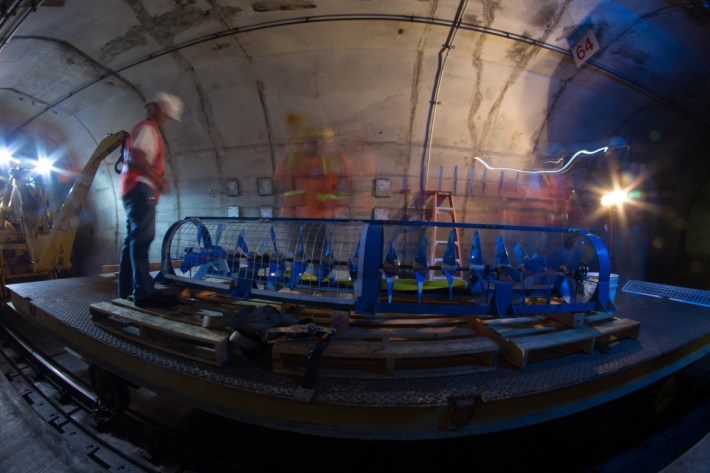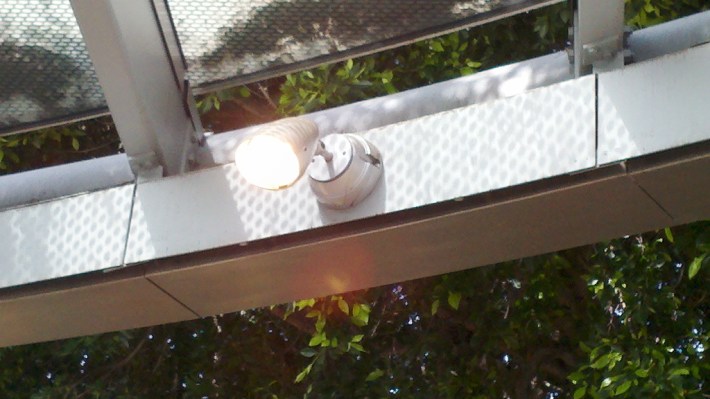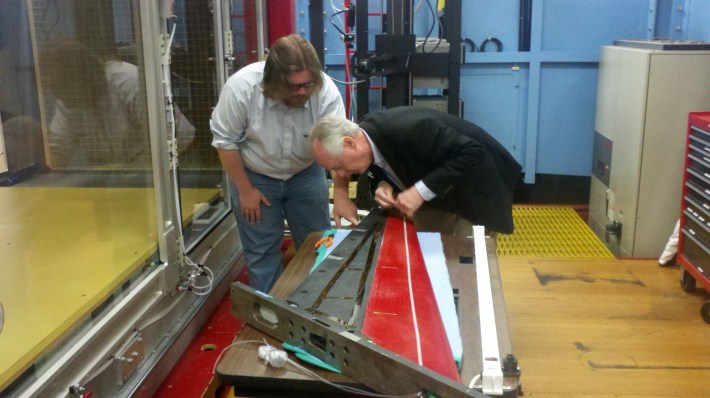
Even if you've never seen “The Seven Year Itch,” you probably know the bit where Marilyn Monroe's skirt is blown by a subway train. Her skirt lifts because subway trains generate wind--lots of wind.
Metro has a “Sustainable Rail Plan” under which its staff looks for ways to reduce power consumption. Cris Liban is Deputy Executive Officer for Environmental Compliance Services, so it's his job to find such opportunities.
“My staff and I were standing one day in the platform and somebody lost their toupee,” he explained. “The wind here in the subway, on the platform, is kind of strong. Maybe we can harness this.” Liban and his colleagues decided to test if they could use a wind turbine to power things such as station lighting, escalators, and perhaps electric vehicle recharging stations.
Around the same time, some engineers were asking Metro about installing turbines along the High Desert Corridor, a project to link Victorville to Palmdale. “Originally we went to L.A. Metro with the idea of doing it with them on an above-ground basis, particularly with the High Desert Corridor,” said Frank Bigelow, President of Pasadena-based WWT Tunnel. “Their response was 'that’s premature,' but they posed the question: ‘could you do something in the tunnel?'”
WWT obliged. A subcontractor built the “Mass Airflow Collection Equipment,” or MACE for short. As the story is written up in Metro's “The Source,” it is likely “the first time a transit agency has tested the effect of having a wind turbine in a subway tunnel.”
A ten-foot prototype was installed last summer and has since been removed for further study. The test concluded that the MACE could gross electricity worth about $6000 per year. The construction and installation cost $600,000.
Expensive perhaps, but it sounds like a great idea for recouping energy. Or is it? I emailed the MACE story to an engineer who worked on Bay Area Rapid Transit in the 1970s.
“Even though the air being pushed does generate electrical power, the increased drag actually requires more energy from the train to push the blades. I would bet that it is a zero sum game if not a loss due to the mechanics and efficiency of the fans,” he said. “Ask a physicist. But I believe that Isaac Newton already did this one.”

So I reached out to some friends at the Jet Propulsion Laboratory. It didn't take long before someone put me touch with Kim Aaron. He did his PhD in Aerodynamics at the California Institute of Technology, where he also used to teach.
Aaron was amused by Metro’s idea and we set a time to meet in Pasadena. We ended up having breakfast at the Athenaeum Club at Caltech, a place that's been visited by such famous minds as Richard Feynman, Stephen Hawking and even Albert Einstein.
Aaron ordered danish and coffee and explained why the MACE project can't work: “Clearly it's air that's driven by the train. It's not as if the tunnel system is open and you have natural wind blowing through,” he said. “What they apparently don't understand is that installing a wind turbine is going to put some back pressure against that air which is ultimately going to push back against the front of the train, so an additional pressure acting on the train which is going to slow the train down or require you to step a little bit more on the gas, so to speak.”
Aaron likened the wind turbine to a wire that siphons electricity from the train motors. “You're putting more energy into the train to keep fighting this back pressure from the wind turbine.”
In fact, he said Metro's turbine is essentially a perpetual motion machine--that's an historic idea for a machine that supposedly runs without energy or generates surplus power from nowhere. They are, by definition, impossible. Today, they're used to teach a basic principle of physics: mainly, that energy always has to come from somewhere, be it the sun, a fuel source such as gasoline, splitting atoms, or the kinetic energy of a train.

Bigelow of WWT Tunnel disagrees.
“Some people have asked, well, gee, aren’t you going to have to use more power to push the train past this thing because of the interference it’s going to cause? Our belief is the answer is ‘no,’ because the machine itself doesn’t create as much of a barrier as the existing signs and electrical boxes that are already in the tunnel,” he said. “But that’s something that presumably needs to be studied more carefully to make sure you’re not creating more problems than you’re solving.”
But as Aaron explained, if the MACE turbine really isn't putting back-pressure on the train, then you could feed its power back into the third-rail. That would accelerate the train and produce more wind--which would spin the MACE faster and produce more power. This could then be looped back into the train again. Ironically, in Metro's own Sustainable Rail Plan report, the writers list “rail propulsion” as a possible use of the MACE energy. Another way to look at it: if the MACE were mounted on the train instead of in the tunnel, it should be obvious why that wouldn't work to generate power. “The fact that they mounted it on the tunnel wall is kind of irrelevant; the principles are the same,” said Aaron.
A subway going down a tunnel produces so much wind because of “piston effect.” Basically, the train acts like the plunger on a bicycle pump.
The cylinder of the bike pump is the tunnel. When you push down on a bike pump, with nothing attached to the nozzle, it's easy. But hold your thumb over the nozzle, hook it to a tire, or attach a turbine to it, and suddenly it becomes harder to push. Felix Schmid is an engineer and professor at the University of Birmingham, England. He’s also director for the the school’s Railway Systems Engineering and Integration program. As he puts it, 75-to-80 percent of the resistance a subway train encounters comes down to this piston effect. “Any obstacle in the air-shafts or vent shafts, including wind turbines, increases the resistance to motion and, as a result, trains use more power.”
Now is where it really gets complicated.
Emilo Graff is Manager of the Lucas Wind Tunnel at Caltech. He tests the aerodynamics of everything from jets to hotdog stands. And he agrees that there's no doubt the turbine is causing the trains to consume more electricity. However, if a turbine were selectively placed and switched on momentarily during a train's passing, it might be possible to recoup some wind energy that would otherwise be lost as heat generated from friction of air molecules bouncing around and striking the tunnel walls. Fathi Tarada is the founder and managing director of Mosen Ltd., a British company that specializes in studying air flows in tunnels. He agrees it's possible to capture some energy that would otherwise be lost, such as by the selective placement of turbines at the subway station entrances or above where the subway portal comes out of the ground.
But, as he explained, the best places to generate power from the turbines are exactly where they put the most drag on the trains. He doubted it would ever be economically sensible to start placing turbines in odd locations here and there, where they'd recoup little energy.
It also requires some pretty advanced “computational fluid dynamics,” the science of predicting air flow. As he said, “you can't just put a turbine in your tunnel and hope for the best.”
About the only way this could work realistically, said the scientists and engineers, is if the turbine were placed in the tunnel and only switched on when a passing train was braking—then it wouldn't matter if drag increased on the train, since it's trying to stop anyway. But there's a much better technology for that. Aaron, Graff and the specialists overseas all agreed that if Metro wants to save energy in the subway, the obvious technology is regenerative braking; that works the same way in a train as it does in a Toyota Prius or Honda Insight.
“In a normal car you hit the brakes and all the energy goes into heating up metal. In a hybrid, you put a load on the wheels, by adding a generator there, so instead of braking and converting to heat, you brake and convert to electricity,” said Graff.
Regenerative brakes are commonplace on trains and Los Angeles Metro's vehicles have the capability. However, if a braking train isn't close to a train that is accelerating—in other words, if there isn't a way to put the braking electricity to immediate use—the electric power is dissipated as heat through banks of resistors. Metro is studying ways to better transfer and store braking electricity as part of the overall “Sustainable Rail Plan” that resulted in MACE.
At this point you might be wondering if anyone noticed the back pressure on the trains during the testing? According to Schmid, who did the math, Metro's turbine only grosses about half a percent of what a train consumes. In other words, it's generating such a small amount of power relative to the train that a driver would never notice he was suddenly losing a few seconds or that he had to put the throttle forward a tiny bit because of the turbine. It would require sensitive equipment to compare how much more power the trains had to consume because of the turbine. Either way, “We didn't measure any on the train side,” said Metro's Liban. “So, I mean, yeah, you may be right. I'm not sure to be honest with you.”
A Metro representative said that back-pressure on the trains is something it will study. It's unclear how, however, since the turbine has been removed.
* This story was first developed with KCRW's Independent Producer Project.






